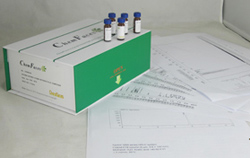Hot Products



| Catalog No. | Information |
| CFN94819 | Pulchinenoside B Pulchinenoside B is a natural product from Pulsatilla chinensis (Bge.) Regel. |
| CFN80305 | Pulchinenoside E1 Reference standards. |
| CFN93286 | Pulegone Pulegone is a fragrance and flavour ingredient. Pulegone has cytotoxicity followed by regenerative cell proliferation is the MOA for Pulegone-induced urothelial tumors in female rats. Pulegone induces a verapamil-sensitive psychostimulant effect that appears to independ on the opening of L-type calcium channels. |
| CFN99938 | Punicalagin Punicalagin has antifungal , antiviral, anti-atherosclerotic, hepatoprotective , anti-obesity., antiproliferative, anti-apoptotic, anti-inflammatory, and antioxidant effects. It can suppress the phosphorylation of MAPK including p38, c-JNK, and ERK, it also has potently inhibiting the activity of fatty acid synthase with half-inhibitory concentration values (IC 50 ) of 4.50μM. |
| CFN98113 | Punicalin Punicalin exerts anti-inflammatory, antioxidative, and anti-hepatotoxic activities, it shows inhibitory activity on HIV-1 reverse transcriptase in a dose-dependent manner, with an IC50 of 0.11 microg/ml (0.14 microM). |
| CFN93410 | Purpureaside C Purpureaside C has significant proinflammatory, antimicrobial and immunomodulating effects. |
| CFN92566 | Purpurin Purpurin is one of the natural colorants extracted from madder roots and other Rubiaceae family plants. Purpurin is a novel specific inhibitor of Adipocyte-derived leucine aminopeptidase, it exhibits anti-angiogenic, antifungal, antibiotic, and antioxidative activities. |
| CFN98246 | Putraflavone Putraflavone possesses a good antioxidant activity via its DPPH free radical scavenging. |
| CFN97778 | Pyrocatechol monoglucoside Reference standards. |
| CFN96169 | Pyrocurzerenone |